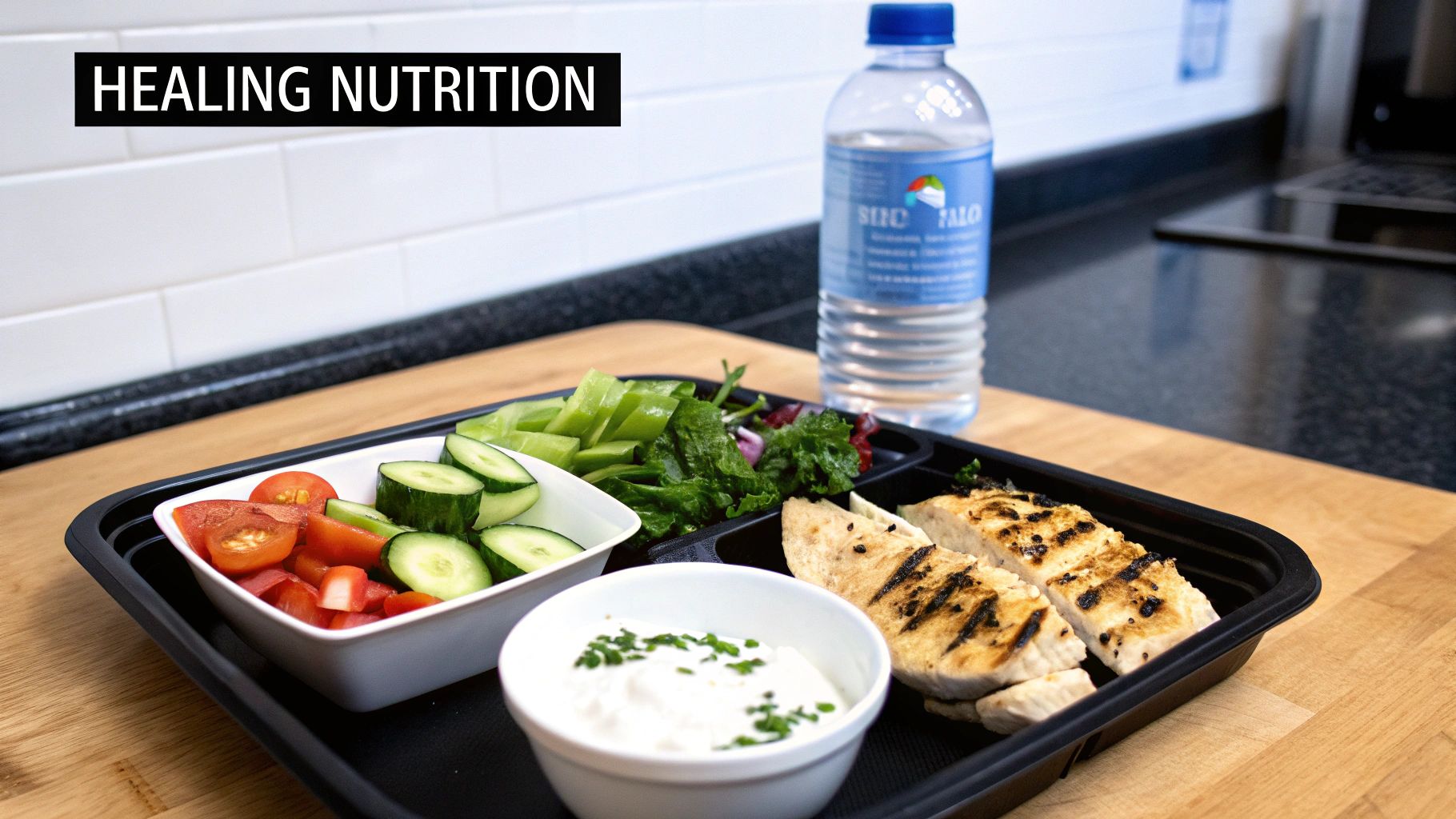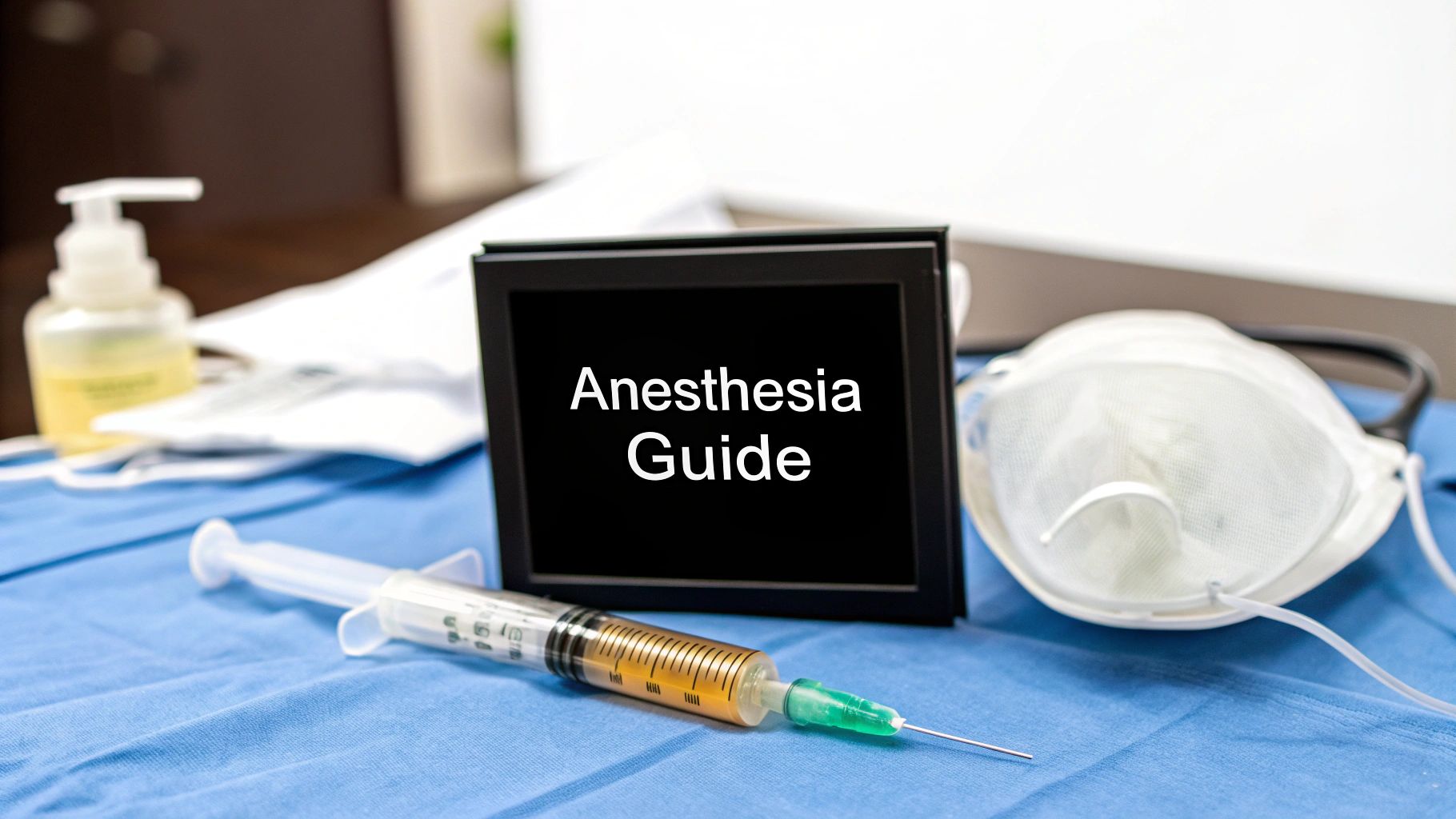
October 13, 2025
8 Essential Mommy Makeover Recovery Tips for 2025
Discover our top 8 mommy makeover recovery tips for a smoother healing process. Learn about pain management, mobility, nutrition, and more for optimal results.
Oct 13, 2025

A mommy makeover is a transformative journey, but the success of your results depends heavily on the recovery period. This phase is not just about waiting; it's an active process of healing, resting, and following precise instructions to ensure your body repairs itself beautifully. While every patient's experience is unique, understanding the key pillars of a successful recovery can make all the difference. This guide provides a comprehensive list of actionable mommy makeover recovery tips designed to empower you with the knowledge needed for a safe, comfortable, and effective healing process.
From setting up your support system to mastering scar care, these strategies will help you navigate the crucial weeks post-surgery with confidence. By preparing for the physical and emotional demands of healing, you can minimize complications and protect your surgical investment. The tips below are structured to give you clear, practical steps for each stage of your recuperation. At practices like Cape Cod Plastic Surgery, Dr. Marc Fater emphasizes a comprehensive recovery plan as a critical component of patient care, ensuring outcomes align with your aesthetic goals. Following this expert guidance is your best path to achieving the stunning results you deserve and making your return to daily life as smooth as possible.
The importance of a robust support system during your mommy makeover recovery cannot be overstated. A mommy makeover often combines several intensive procedures, such as a tummy tuck, breast augmentation or lift, and liposuction. This means your body needs significant time to heal, and your mobility will be severely limited, especially during the first one to two weeks.

During this initial phase, you will be unable to lift anything heavier than 10 pounds, which includes young children, grocery bags, and laundry baskets. This makes dedicated assistance absolutely essential for a safe and smooth recovery.
Your support network can consist of various people, and it's wise to coordinate their roles before your surgery date.
Waiting until after your surgery to organize help is too late. Proper planning is one of the most critical mommy makeover recovery tips you can follow. Create a detailed schedule and list of tasks to avoid confusion and ensure all your needs are met. For a more in-depth look at pre-operative planning, you can explore our guide on how to prepare for surgery. By setting up your support system in advance, you empower yourself to focus entirely on resting and healing.
Among the most critical mommy makeover recovery tips is the diligent use of compression garments. These are not simple shapewear; they are medical-grade elastic garments engineered to support healing tissues, minimize swelling, and help your body conform to its new contours. Following procedures like a tummy tuck or liposuction, these garments apply steady, gentle pressure to reduce fluid buildup and improve blood circulation.
Surgeons typically require patients to wear them continuously, often 24/7, for the initial 4 to 6 weeks, removing them only for showering. Consistent wear is crucial for achieving the best possible surgical outcome and ensuring a smoother, more comfortable healing process.
Depending on your specific combination of procedures, your surgeon will prescribe different types of compression wear. Each is designed to target a specific area and aid in its unique healing requirements.
Adherence to your compression schedule is a non-negotiable part of your recovery. To make it more manageable, plan ahead. Purchase at least two or three garments so you can have one to wear while the others are being washed. When washing, use a gentle detergent and always air dry to maintain the garment's elasticity. If you experience chafing, a light dusting of cornstarch-free powder or a thin barrier cream can provide relief. For more information on post-operative care, consider resources like the American Society of Plastic Surgeons' recovery guidelines. Always consult your surgeon before making any adjustments to your wear schedule.
Effective pain management is a cornerstone of a successful mommy makeover recovery. Instead of chasing pain after it becomes severe, the modern approach is to stay ahead of it. This proactive strategy involves a multimodal protocol, combining different types of medications and non-pharmaceutical techniques to keep you comfortable while minimizing reliance on strong narcotics.
Following your surgeon's prescribed schedule, especially in the first 48 to 72 hours, is crucial. Waiting until pain is intense to take medication makes it much harder to control. Proactive management reduces physical stress, improves your ability to rest, and allows for gentle, necessary movements that aid in healing.
Surgeons today often utilize Enhanced Recovery After Surgery (ERAS) protocols, which are designed to optimize recovery and reduce opioid use. This approach is one of the most important mommy makeover recovery tips for a smoother experience.
Your comfort is key to a positive recovery. A well-managed pain plan allows your body to dedicate its energy to healing. Create a medication log and set alarms to ensure you stay on schedule without fail. For a deeper dive into modern techniques, you can explore our detailed guide on pain management after surgery. By actively participating in your pain protocol, you take control of your comfort and set the stage for a more pleasant recovery.
While rest is critical, strategic and gradual movement is a cornerstone of a successful mommy makeover recovery. Moving too little can increase the risk of serious complications like blood clots, while moving too much or improperly can strain incisions and compromise your results. The key is to find the right balance, progressively increasing your activity level according to your surgeon’s specific timeline.
This approach ensures you promote healthy circulation and prevent stiffness without putting undue stress on healing tissues from your tummy tuck, breast surgery, or liposuction. Each procedure has unique restrictions, making it vital to adhere to a structured mobility plan.
Your activity level will evolve week by week. It’s essential to listen to your body and follow the guidelines set by your surgical team, as they are tailored to your specific combination of procedures.
The following timeline visualizes the key phases of reintroducing mobility and activity after your mommy makeover surgery.

This visual progression underscores how recovery is a multi-stage process, starting with minimal movement and building methodically over two months.
Protecting your surgical sites while staying mobile requires mindful movement. Avoid any activity that causes a pulling or painful sensation.
Always remember to use proper body mechanics. For instance, log-roll out of bed to avoid engaging your core muscles, and bend at the knees rather than the waist to pick something up. These small adjustments protect your abdominal repairs and help ensure a smooth, complication-free healing journey.
Optimal nutrition and hydration are not just beneficial; they are fundamental to the healing process after a mommy makeover. Your body requires significantly more calories, protein, vitamins, and minerals to effectively repair tissues, fight off potential infections, and build new collagen. Proper hydration is equally critical, as it supports circulation, helps flush anesthesia from your system, prevents constipation from pain medication, and reduces swelling.

Adopting a diet focused on healing means emphasizing lean proteins, anti-inflammatory foods, and nutrient-dense options. Conversely, you should avoid foods that can increase inflammation, such as processed sugars and excessive sodium, which can worsen swelling and hinder your recovery.
A well-planned menu removes the guesswork and stress from post-operative eating, ensuring your body gets the fuel it needs. Many surgeons recommend consuming 25-30 grams of protein per meal and drinking at least 64-80 ounces of water daily.
One of the most effective mommy makeover recovery tips is to prepare your kitchen before your surgery. Prepping meals and snacks allows you to focus solely on healing without worrying about cooking. You can explore our detailed advice on what to eat after plastic surgery for a more comprehensive food list. By prioritizing your diet, you provide your body with the essential building blocks for a faster, more comfortable recovery.
Proper sleep positioning is non-negotiable during mommy makeover recovery. It directly impacts your comfort, protects incision sites, and can significantly reduce post-operative swelling. Since a mommy makeover often includes a tummy tuck and breast procedures, you must avoid putting pressure on your abdomen and chest, making sleeping on your back in a semi-reclined position essential.
This elevated position (typically 30-45 degrees) for the first two to three weeks minimizes tension on your abdominal incision and helps fluid drain away from your breasts, promoting faster healing. Quality sleep itself is a powerful recovery tool, as your body performs most of its tissue repair and releases growth hormones during deep sleep cycles.
Creating the right setup before your surgery is one of the most practical mommy makeover recovery tips you can follow. A comfortable and supportive sleep station prevents strain and helps you rest more deeply.
Beyond just the position, a holistic approach to your sleep environment can make a world of difference. Ensure your bedroom is a sanctuary for healing.
Your mommy makeover journey doesn't end when you leave the operating room; diligent post-operative care is a critical part of the process. Attending all scheduled follow-up appointments and actively monitoring for any signs of complications are non-negotiable mommy makeover recovery tips for ensuring your safety and achieving the best possible results. These appointments allow your surgeon to track your healing progress, manage any issues before they escalate, and provide timely guidance.
Surgeons schedule these visits at key recovery milestones (e.g., 24-48 hours, one week, six weeks, and beyond) to perform essential tasks like removing surgical drains, assessing incision healing, and clearing you for increased activity. Between these visits, you become the most important member of your care team, responsible for watching for warning signs of infection, fluid collection (seroma), or blood clots.
Your surgeon provides specific instructions on what to watch for, but staying vigilant is your responsibility. Early detection is paramount and can prevent a minor issue from becoming a serious health concern. For instance, a patient who noticed unusual swelling was able to have a seroma drained in-office during their one-week appointment, avoiding a more invasive procedure. Similarly, catching a minor infection at the first 48-hour check-up can allow for a quick resolution with oral antibiotics.
To get the most out of your post-operative care, treat your follow-up appointments and self-monitoring with the seriousness they deserve. Never skip a visit, even if you feel you are healing perfectly. Proper monitoring is one of the most vital mommy makeover recovery tips you can follow. Keep a detailed recovery journal to track your symptoms, pain levels, and any questions that arise between appointments. For more insights into the recovery timeline, you can review our detailed guide on the mommy makeover recovery timeline. By staying engaged and communicative, you partner with your surgical team to ensure a safe, smooth, and successful recovery.
One of the most crucial mommy makeover recovery tips for achieving beautiful, long-lasting results is diligent scar care. A mommy makeover involves incisions for procedures like a tummy tuck and breast lift, and how these incisions heal directly impacts your final aesthetic outcome. Proper management minimizes scar visibility, prevents complications like infection or hypertrophic scarring, and ensures your results look as natural as possible.
The process of scar care evolves as you heal. Initially, the focus is on keeping incisions clean and protected to support proper wound closure. Once the incisions are fully healed, the strategy shifts to active scar maturation, a phase that can last for over a year.
Your scar care routine should adapt to your stage of recovery. Following your surgeon's specific instructions is paramount for a smooth healing process.
Patience and consistency are the keys to effective scar management. A well-executed scar care plan is a vital part of your mommy makeover recovery tips toolkit. Protect your healing skin from the sun for at least 12 months using a broad-spectrum SPF 30+ sunscreen to prevent hyperpigmentation, which can make scars darker and more noticeable. For those with concerns about scar development, understanding advanced options is helpful. You can explore the possibilities by reading this guide on scar revision surgery and improving confidence through care. Remember, scars continue to fade and mature for 12 to 18 months, so long-term care yields the best results.
The journey through mommy makeover recovery is a profound and personal experience, one that requires as much mental fortitude as it does physical healing. By now, you understand that a successful outcome isn't just about the surgery itself; it's about the deliberate, thoughtful actions you take in the weeks and months that follow. Mastering these mommy makeover recovery tips is your final, essential contribution to achieving the beautiful results you envisioned.
Let's distill the core principles we've covered. Your recovery hinges on a few crucial pillars:
Embracing this recovery period with patience is perhaps the most powerful tool at your disposal. Each day brings you closer to your final, stunning transformation. Be kind to yourself, celebrate small milestones, and allow your body the time it needs. Following this structured approach to recovery doesn't just minimize complications; it empowers you, giving you control over the final chapter of your transformative journey and ensuring your results are everything you hoped for and more. This dedicated aftercare is the bridge between a successful surgery and a lifetime of enjoying your renewed confidence.
Ready to take the next step in your aesthetic journey with a team that prioritizes patient education and personalized care? Schedule a consultation with the experts at Cape Cod Plastic Surgery to discuss your goals and develop a comprehensive plan that includes detailed mommy makeover recovery tips tailored just for you. Visit us at Cape Cod Plastic Surgery to learn more.

October 13, 2025
Discover our top 8 mommy makeover recovery tips for a smoother healing process. Learn about pain management, mobility, nutrition, and more for optimal results.

October 13, 2025
Journey of Triumph: Stories of Healing, Hope, and Health

October 12, 2025
Discover the main anesthesia types for surgery. This guide explains general, regional, local, and sedation to help you prepare for your procedure.